Midterm Report
This is our midterm report for our CS 7641 Group Project, which aims to analyze home credit risk. This report is an initial iteration of our project that builds off of the concepts outlined in our project proposal.
Table of contents
- Introduction / Background
- Problem Definition
- Data Collection
- Data Visualizations
- Methods
- Results and Discussion
- Team Contributions
- References
Introduction / Background
Banks and financial institutions act as money lenders and provide loans, as well as credit lines for millions of customers worldwide. However, for them to operate in a profitable manner and reduce the risk of their customers defaulting on payments for loans, they have to be able to accurately assess an individual’s potential to default on their credit (in general, their overall credibility). This is also highly beneficial for them to determine the amount of interest that they should be charging on a given loan, and overall, whether they should offer the loan in the first place. This project is based around building a binary classification model that can be used to predict whether a borrower will default on their loan (meaning that they are unable to pay back a loan provided by a financial institution). A review of relevant literature showed us that privately securitized adjustable-rate mortgages have much more variance in performance when compared to retained mortgages, underscoring the importance of providing financial institutions with the best tools to aid decision making processes (Krainer & Laderman, 2013). Delving into the literature revolving around this topic also greatly helped influence decisions made for this report, which will be elaborated on further in later sections.
For this project, our team opted to use the dataset provided by the Home Credit Group from a Kaggle competition. This data set has over 100 features about loan applicants and their credit risk. The dataset can be found at this link. In later sections, we discuss how we processed, cleaned, and reduced the data set to create a binary classification model to determine if applicants will default or not.
Problem Definition
In today’s volatile housing market, numerous potential borrowers face challenges in securing loans, often hindered by limited or absent credit histories. This situation breeds opportunities for unscrupulous lenders to exploit such individuals, while traditional banks miss out on viable clients due to irregular assessment methods. Emphasizing the crucial need for accurate predictions of loan repayment, it’s imperative to ensure that qualified borrowers aren’t unjustly denied. Equally vital is the early identification of likely defaulters to avert financial losses. Relying solely on manual risk assessment is not only time-consuming but also subject to human biases and inconsistency. Therefore, the development of a model to categorize individuals based on their repayment risk is essential. Such a model can help financial institutions streamline the evaluation process, enhance consistency in risk assessment, and significantly lower the incidence of loan defaults.
Data Collection
Our initial dataset for training the binary classification model, aimed at predicting home credit loan defaults, was extensive, comprising 122 features (columns) and over 300,000 instances (rows). This also primarily came from a singular file, application_train.csv. For this portion of the project, we focused on the features present in that file, and for the final portion of the project, we hope to integrate and use features from other files present in the dataset, as they also contain relevant data as well (we opted to prioritize processing the data in this file due to time constraints). Recognizing the need for dimensionality reduction, after downloading and reading through the dataset and relevant descriptions, we had to clean up the data to prepare it for classification by our models. We completed the following steps, described below, to clean our data set:
-
Data Cleaning and Feature Selection: We initiated our process by identifying features with substantial missing data, specifically those with over 50% missing values. This criterion led to the elimination of several columns, primarily consisting of incomplete data or binary flags, which were impractical for meaningful imputation. This decision aligns with practices recommended in Bao et al. (2019) and de Castro Vieira et al. (2019), who both recommend against the use of substantial missing data, as filling in missing values can lead to data distortion, and that many missing data points can harm accuracy. Bao et al. specifically stated that their cleaning approach started with: “for the features not filled out by 95% of applicants or above, we removed this feature.” These papers, along with other sources from our initial literature review and background research, underscore the importance of data quality and relevance in predictive accuracy.
-
Validation of Feature Removal: To validate our feature removal decisions, we utilized a Decision Tree Classifier. We opted to utilize this approach based on information supported by Emad Azhar Ali et al. (2021). This helped us confirm that the eliminated features had minimal impact on predicting loan defaults, ensuring the retained data’s relevance and quality, while also highlighting features that might have significant relevance towards predicting an individual defaulting on a home loan.
from sklearn.tree import DecisionTreeClassifier import matplotlib.pyplot as plt import pandas as pd def get_feature_imp(X_train, y_train): tree = DecisionTreeClassifier() tree.fit(X_train, y_train) importances = tree.feature_importances_ feat_importances = pd.DataFrame(importances, index=X_train.columns, columns=["Importance"]) feat_importances.sort_values(by='Importance', ascending=False, inplace=True) feat_importances.plot(kind='barh', figsize=(80,60))The above code generated the following plot, which can be viewed separately (with zoom capabilities) by clicking here:
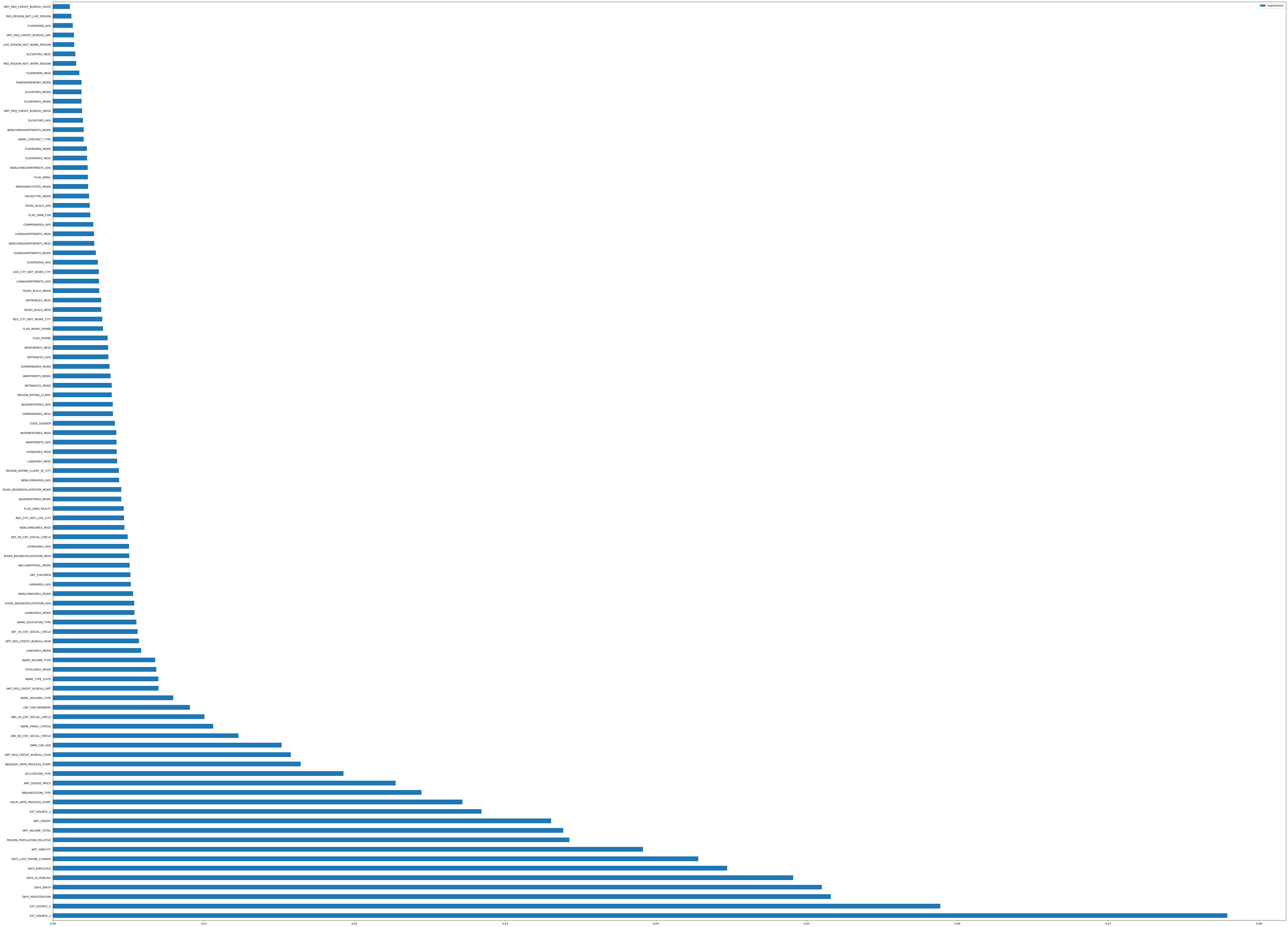
-
Handling Categorical Data: We then addressed the challenge of categorical data, transforming string or object data types into discrete numerical codes. This conversion is crucial for compatibility with machine learning algorithms, as noted in Krainer and Laderman (2013). We utilized
pandasfor this approach, and a snippet of the code achieving this is shown below: -
Imputation of Missing Values: For the remaining features, our strategy for handling missing values varied based on the feature context. For instance, null values in ‘OWN_CAR_AGE’ were interpreted as the absence of a car and replaced with zeros. This approach of context-sensitive imputation is supported by Bao et al. (2019), emphasizing the importance of maintaining data integrity.
-
Advanced Imputation Techniques: For features where zero imputation was inappropriate, we initially applied
sklearn’s SimpleImputer with -1 as a placeholder. Recognizing the limitations of this naive approach, we plan to explore more sophisticated methods, such as the K-Nearest Neighbors (KNN) imputer. However, our trial with KNN imputation proved time-consuming (the runtime was taking far too long, eliminating it from consideration). That being said, its potential for more accurate imputation, as suggested by de Castro Vieira et al. (2019), warrants future consideration in the final portion of the project. -
Dimensionality Reduction with PCA and Data Normalization: Prior to applying Principal Component Analysis (PCA), we utilized the RobustScaler for data normalization. The RobustScaler is particularly effective in datasets with outliers, as it scales features using statistics that are robust to outliers. This scaler subtracts the median and scales the data according to the Interquartile Range (IQR). In the context of credit data, where outliers can significantly skew the data distribution, this method ensures that our PCA is not influenced unduly by extreme values. This scaling approach, therefore, enhances the effectiveness of PCA, which we applied to reduce our feature set to 40 principal components. By choosing 40 components, we captured approximately 95% of the variance in the dataset, striking an optimal balance between dimensionality reduction and information retention, as recommended by Emad Azhar Ali et al. (2021). This balance is crucial in machine learning, as it preserves essential data characteristics while reducing computational complexity. Finally, we divided our dataset using an 80/20 training-test spli using
sklearn, following a standard practice for evaluating model performance in machine learning.def run_pca(df: pd.DataFrame, n_components: float) -> pd.DataFrame: # Standardize the data X_std = RobustScaler().fit_transform(df) # running PCA pca = PCA(n_components=n_components) principal_components = pca.fit_transform(X_std) principal_df = pd.DataFrame(data=principal_components, columns = [f'Component {x}' for x in range(1, principal_components.shape[1] + 1)]) return principal_df
This comprehensive data preparation process ensures a robust, relevant, and efficient dataset, ready for deploying in our binary classification model to predict home credit loan defaults.
Data Visualizations
To help us understand the dataset better, we plotted many features using pandas and plotly. First, we wanted to determine the balance of our dataset for the binary classification, so we examined the number of non-defaults, 0, and the number of defaults, 1.
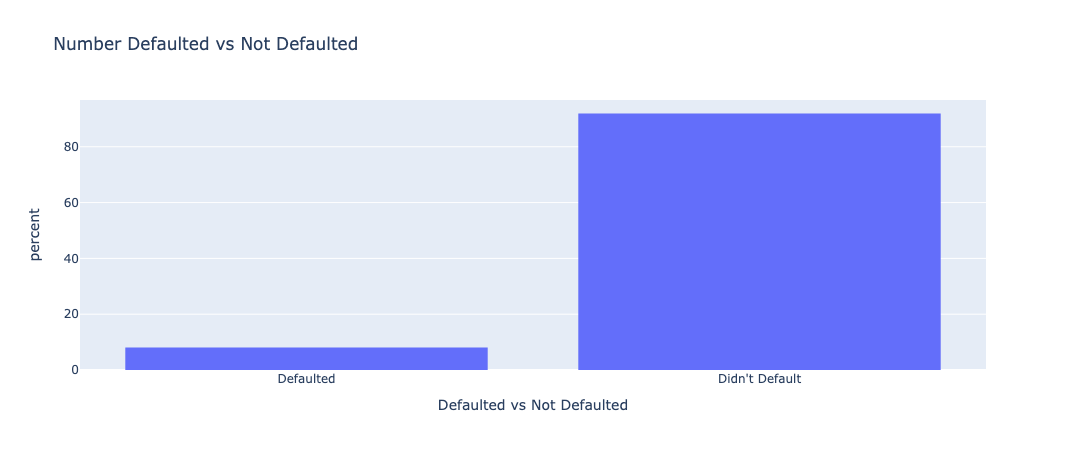
This chart shows that the dataset is heavily skewed in favor of people who didn’t default on their loans, which is representative of the real world. That implies that high accuracy results aren’t necessarily a sign of a working algorithm, and that we would need to use other metrics to make sure our models work properly.
We then wanted to examine the income distribution of the individuals who were represented in the data set.
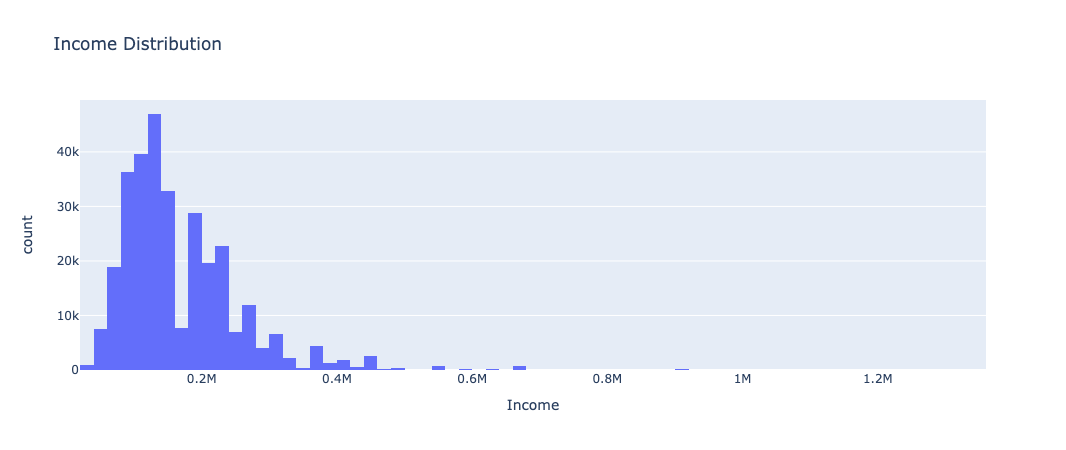
This chart just shows the income distribution of our dataset, without some heavy outliers with an absolute z-score of 5 or higher. The distribution matches up with a generic population distribution of incomes, which shows that our dataset is a good representation of larger populations.
The following charts are overlayed histograms which divide the data by default status, with the orange being those who did default and the blue representing those who didn’t default. All of the charts are normalized around the likelihood of any datapoint landing in a certain bin given a person’s default status, as just measuring the total count isn’t very useful since so many more people didn’t default than those who did. The dataset also included credit ratings and history from other external sources (EXT_SOURCE_1, EXT_SOURCE_2, EXT_SOURCE_3), and we knew that we wanted to explore these features more to understand their impact on classifier results:
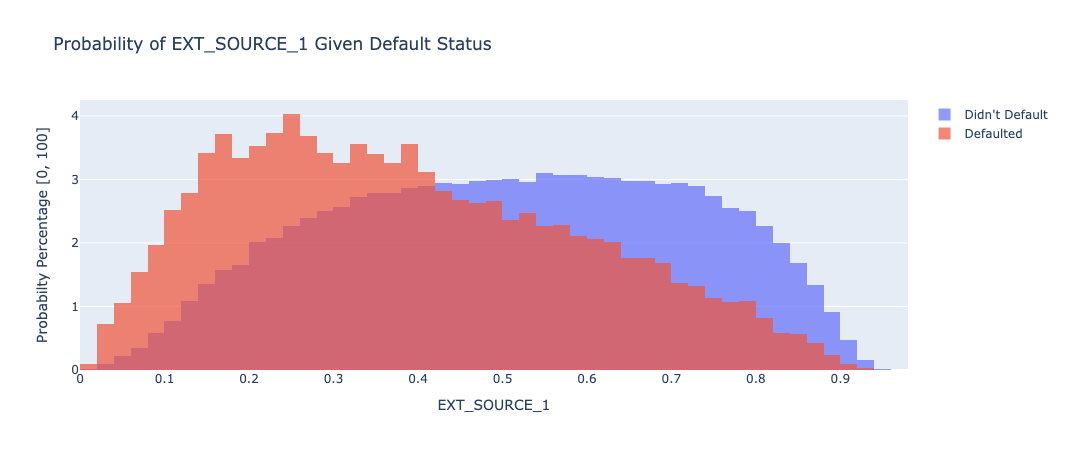
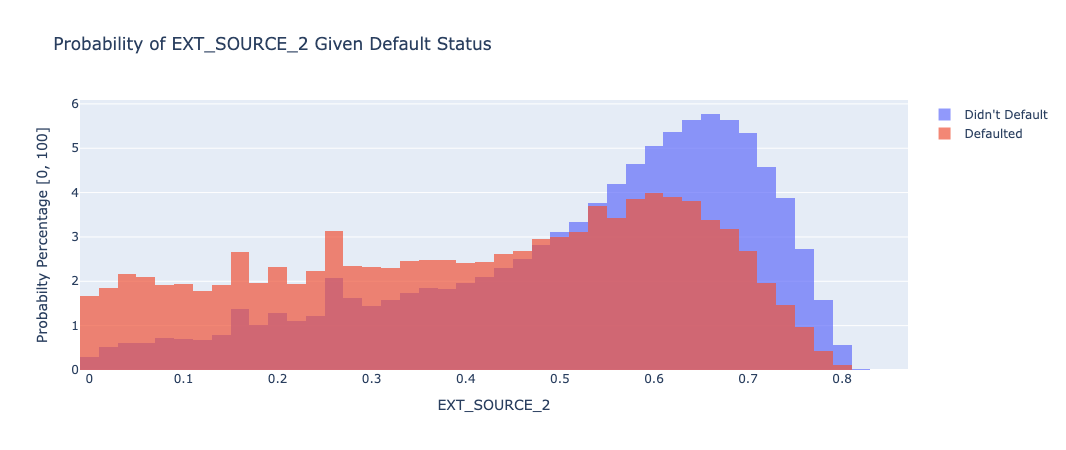
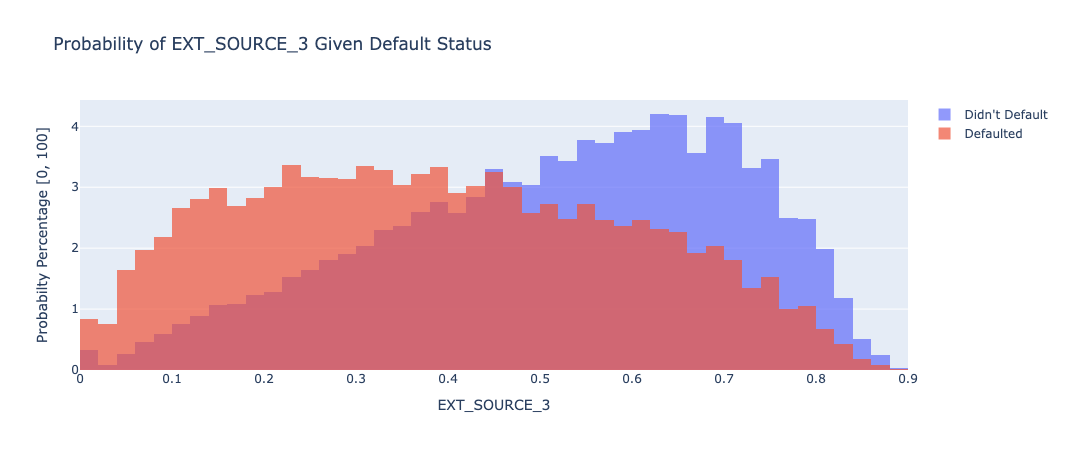
EXT_SOURCE_1: This chart shows that the EXT_SOURCE_1 metric predicts a higher value for those who are less likely to default, and does a fairly good job of splitting the data, although it’s a very gradual split.
EXT_SOURCE_2: This chart shows that the EXT_SOURCE_2 metric predicts a higher value for those who are less likely to default, and can predict the likelihood of not defaulting pretty well, though it has a more uniform distribution for those who did end up defaulting.
EXT_SOURCE_3: EXT_SOURCE_3 also predicts a higher value for those who are less likely to default, and follows a similar distribution to EXT_SOURCE_1, with a higher emphasis on those who didn’t default.
Aside from external sources, we also found some metrics that have relationships with default status. These plots are shown below:
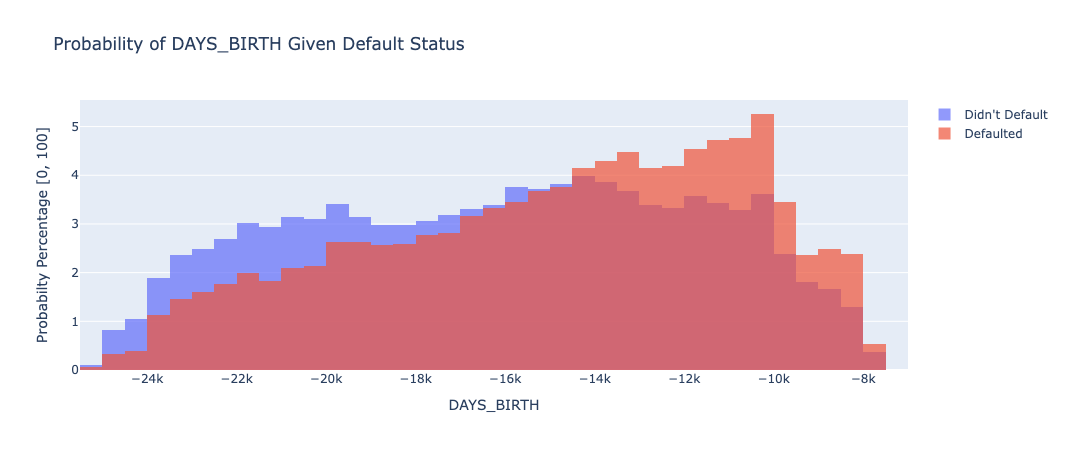
The amount of days since your birth seems to directly relate to a person’s default status. The more days since you were born (the older you are), the less likely it seems you are to default.
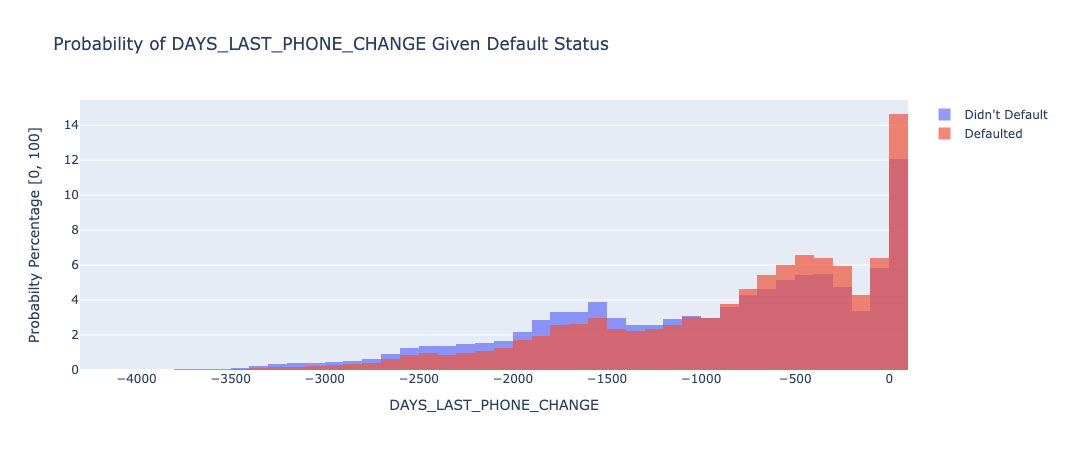
Finally, we examined some demographics and and general information regarding each of the individuals included in the data set. Some significant or interesting plots of the data are shown below:
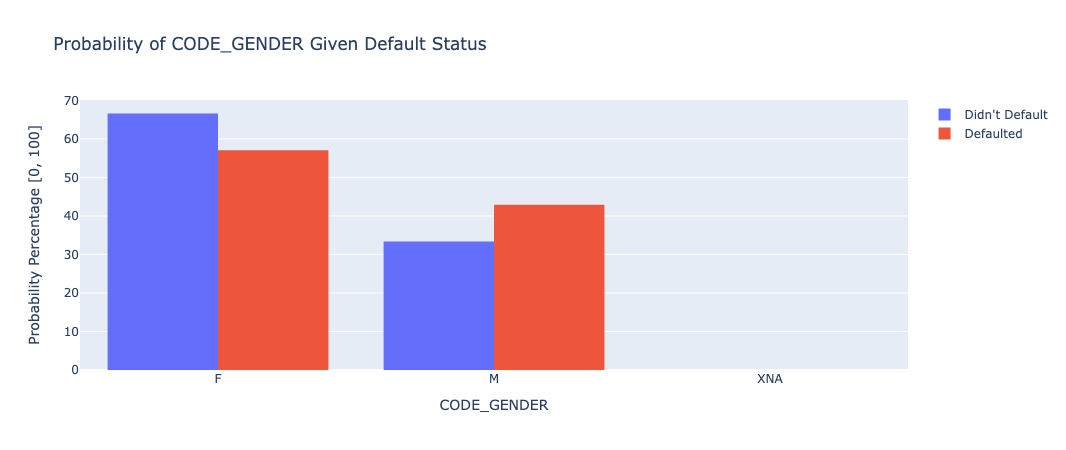
The graph shows that there are more people who identified as female in the dataset, and overall, males were more likely to default on their loans.
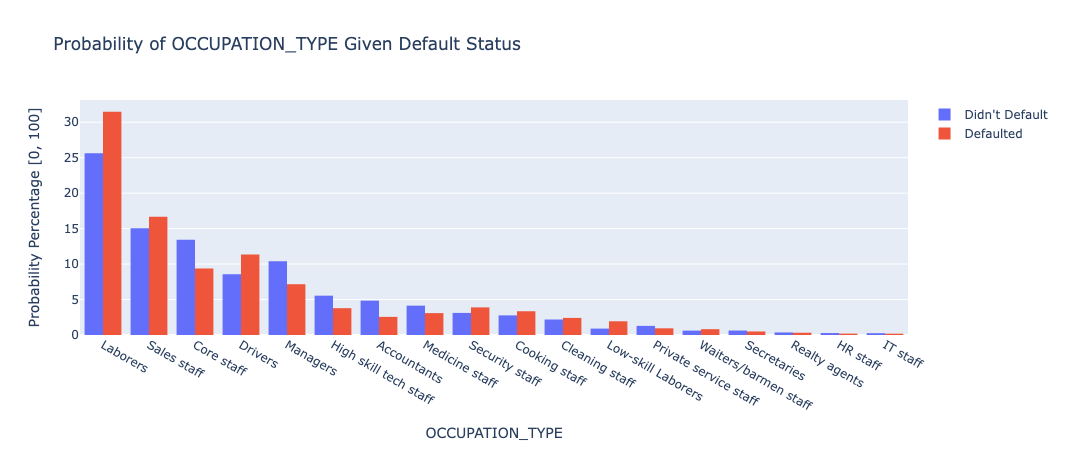
Overall, people with occupations which usually pay more seemed to default significantly less. Those occupations include: core staff, managers, high skill tech staff, accountants, medicine staff, and private service staff. The rest of the occupations were either about even or had higher proportions of people who defaulted.
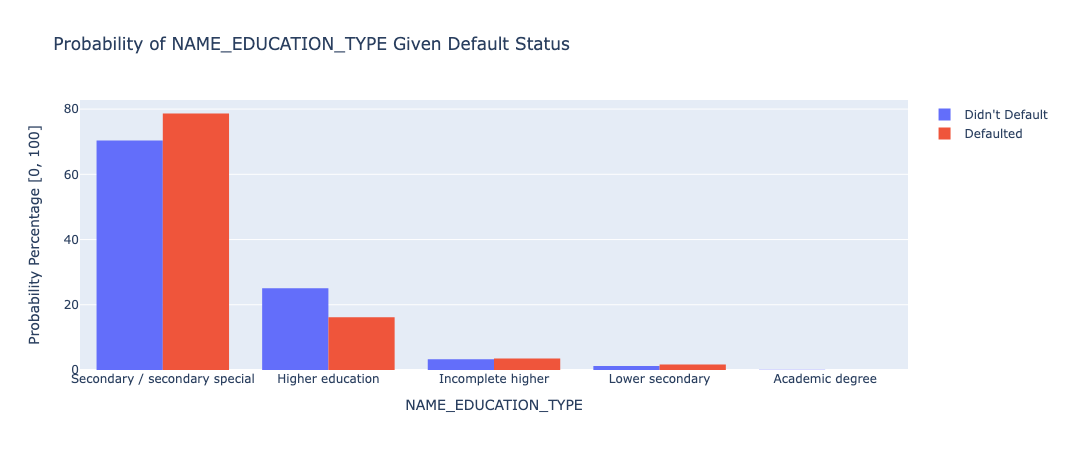
Similar to occupation, people with a higher level of education ended up comprising a smaller portion of those who defaulted on their loans.
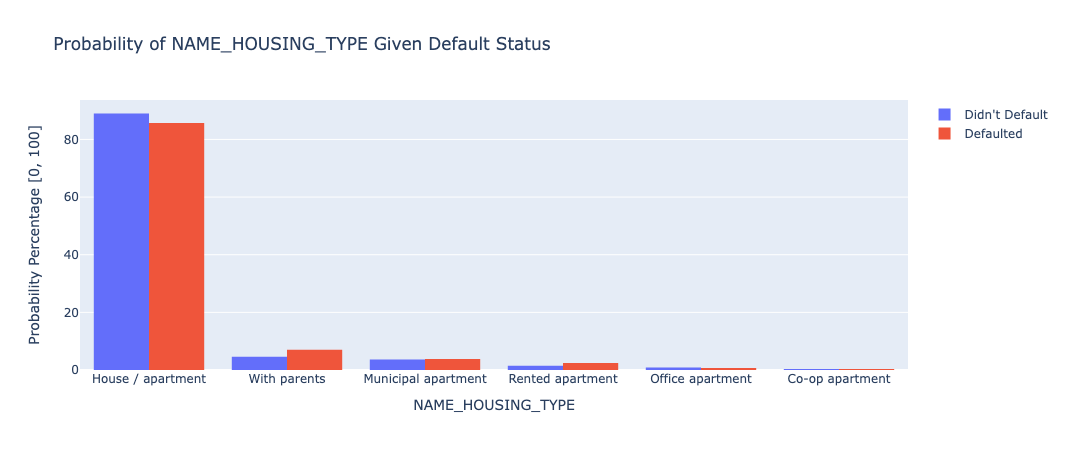
Those who live in their own housing comprise a relatively smaller proportion of those who defaulted than those who didn’t, while almost every other housing type did the opposite.
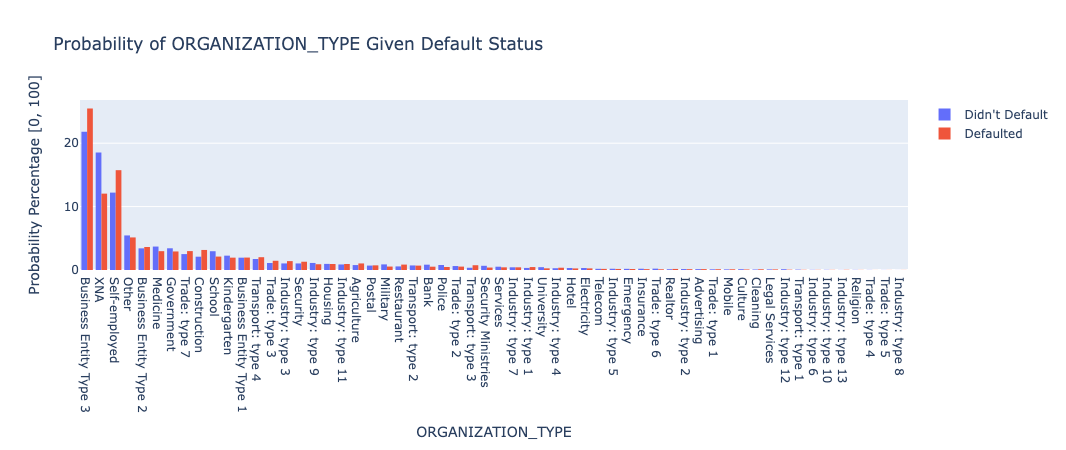
This dataset is harder to analyze as there are a lot of categories that divide the data, but it also displays the different organizations people are in and what percentage of those who defaulted and those who didn’t came from each type of organization.
Overall, these visualizations helped our group understand the data set better, give us insights into important features, and how to best prepare them for classification.
Methods
After rigorously cleaning and processing our dataset, we advanced to the phase of training classifiers and generating predictions on the test data set aside for validation. We selected two distinct classifiers for this task: the Support Vector Classifier (SVC) and the Logistic Regression Classifier. The choice of SVC and Logistic Regression was strategic, given their proven efficacy in binary classification problems. These models are well known for their ability to handle high-dimensional data efficiently and are less prone to overfitting, especially relevant given the size of our dataset. This consideration is crucial, as models like Neural Networks, while powerful, typically require substantially larger datasets to perform effectively and were thus deemed unsuitable for our current data volume.
To ensure the best possible performance of each classifier, we applied appropriate feature scaling techniques. The RobustScaler was used prior to deploying the Support Vector Classifier. This scaler’s resilience to outliers makes it particularly suited for datasets where such extreme values may be present, ensuring that the SVC operates on a more uniform and representative feature space. Conversely, we employed the StandardScaler for the Logistic Regression Classifier. This scaler standardizes features by removing the mean and scaling to unit variance, a procedure that aligns well with the assumptions underlying logistic regression and enhances its performance.
Upon training both classifiers on the training data, we employed the balanced accuracy metric to evaluate their performance on the unseen test data. Balanced accuracy is an appropriate choice for our dataset, especially if the class distribution is imbalanced, as it takes into account the true positive rate and the true negative rate, providing a more nuanced understanding of model performance across both classes.
Looking ahead, we plan to refine these models further by tuning their hyperparameters. This process will involve experimenting with different values for regularization strength and other relevant parameters, aiming to optimize the models’ performance. Such hyperparameter tuning is expected to enhance the models’ generalization capabilities, thereby improving their predictive accuracy on new, unseen data.
The code for the classifiers is shown below:
def fit_svm_classifier(X, y):
pipeline = make_pipeline(RobustScaler(), LinearSVC(random_state=0, tol=1e-5, class_weight="balanced"))
pipeline.fit(X, y)
return pipeline
def fit_logistic_regression(X, y):
regression = LogisticRegression(class_weight= "balanced", solver="newton-cholesky", max_iter=5000, n_jobs=-1)
pipeline = make_pipeline(StandardScaler(), regression)
pipeline.fit(X, y)
return regression
def run_and_compare(train_X, train_y, test_x, test_y):
print(f"baseline balanced-accuracy-score: {balanced_accuracy_score(test_y, np.zeros(test_y.shape))}")
print("Running Support Vector Classifier ....")
svm = fit_svm_classifier(train_X, train_y)
svm_balanced_accuracy = balanced_accuracy_score(test_y, svm.predict(test_x))
print(f"SVM balanced accuracy: {svm_balanced_accuracy}")
plot_confusion_matrix(test_y, svm.predict(test_x), title="Support Vector Machine Confusion Matrix")
print("Running Logistic Classifier ....")
logit = fit_logistic_regression(train_X, train_y)
logit_balanced_accuracy = balanced_accuracy_score(test_y, logit.predict(test_x))
print(f"Logistic Classifier balanced accuracy: {logit_balanced_accuracy}")
plot_confusion_matrix(test_y, logit.predict(test_x), title="Logistic Regression Confusion Matrix")
Results and Discussion
The classification task at hand presents an inherent class imbalance, a common obstacle in credit prediction scenarios where defaults are considerably less frequent than non-defaults. To aptly measure model efficacy, we opted for balanced accuracy over raw accuracy, as it accounts for the skew in class distribution. Balanced accuracy offers a more nuanced assessment by considering the model’s ability to correctly predict both classes.
Our initial model, a baseline majority class classifier, predicted a non-default for all instances, achieving a 50% accuracy, which is expected in a binary classification with imbalanced classes. Upon applying the Support Vector Classifier (SVC) post-normalization with the RobustScaler, the balanced accuracy improved to 65%. This notable enhancement over the baseline underscores the model’s improved discriminatory power. The SVC’s confusion matrix reveals a tendency to predict non-defaults more accurately (73%) compared to defaults (54%). While better than guessing, there’s room to minimize the false negative rate, which stands at 46%. The confusion matrix is shown below, and can be viewed separately by clicking here:
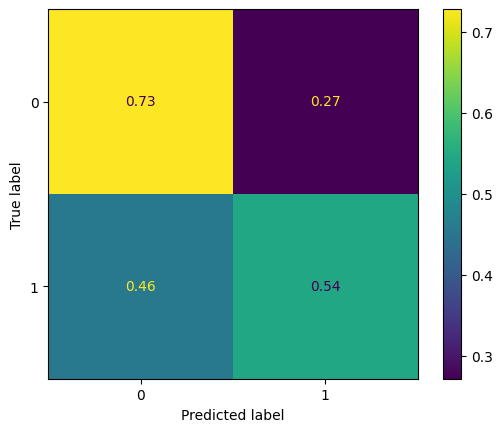
In comparison, the Logistic Regression Classifier, normalized with the StandardScaler, achieved a balanced accuracy of 53.3%. Although this is an improvement over the baseline, it’s a modest one. The corresponding confusion matrix shows a high true positive rate for non-defaults (81%) but also indicates a significant portion of defaults being misclassified (12% false negative rate). This disparity suggests that the Logistic Regression model is more conservative in predicting defaults. The confusion matrix is shown below, and can be viewed separately by clicking here:
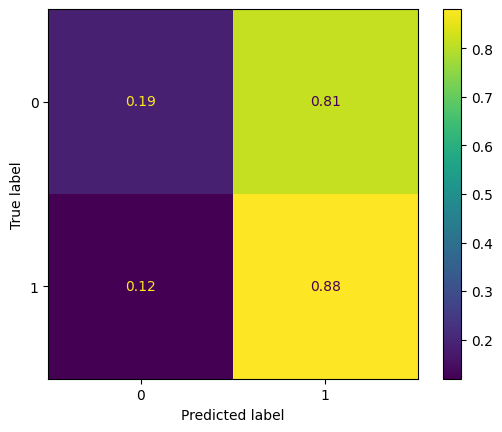
The divergence in performance between the SVC and Logistic Regression models, as evidenced by their confusion matrices, mandates further inquiry and investigation into feature selection and model tuning. The SVC’s propensity to misclassify defaults less frequently than the Logistic Regression model could point to differences in how these models handle decision boundaries in high-dimensional space.
To advance our models’ predictive capabilities, we hope to follow this approach:
- Firstly, conducting a thorough feature engineering process to unearth more predictive signals.
- Secondly, implementing a hyperparameter optimization routine. This will leverage techniques such as cross-validation and grid search to fine-tune regularization parameters, which could yield a more balanced trade-off between sensitivity and specificity.
- Furthermore, exploring ensemble methods or more complex models like Random Forests, given more data, could potentially offer better generalization and robustness against the class imbalance challenge.
By iteratively refining our models with these strategies, we aim to increase balanced accuracy, reduce misclassification rates, and move closer to a model that can reliably predict credit defaults with higher confidence. More details about next steps, beyond what was previously described, are discussed in the Project Timeline section of this report.
Team Contributions
Contribution Table
| Yash Gupta | Reetesh Sudhakar | Nityam Bhachawat | Mark Nathaniel Glinberg |
|---|---|---|---|
| Methods (Classifier, Data Pre-processing), Potential Results & Discussion (Classifier Metrics) | Project Website Management & Documentation, Introduction & Background, Problem Definition, Literature Review, Methods (Data Pre-processing) | Dataset Exploration & Pre-processing (manual feature selection selection via code), Classifier code, Results (Metric Analysis) | Project Timeline, Project Introduction & Background, Literature Review, Dataset Visualization and Exploration (manual feature selection & processing), Data Pre-processing |
Project Timeline and Gantt Chart
Our team used the Gantt Chart that was created earlier in the semester to track our progress and maintain accountability between one another. We checked off certain boxes as our work progressed, and the updated Gantt Chart is included below. To access view the Excel file and download it, please click here.

Moving forward, our team has established the following goals and timelines for the final portion of the project:
- Explore the dataset further (1 - 2 weeks): Though the dataset that we worked with up until this point had over 100 features, it was a small portion of the provided dataset. For the final portion of the project, we want to integrate features from other portions of the dataset.
- Create custom features (0 - 1 week): From examining the dataset, we noticed that certain features can be combined in some aspect to create a new feature that may be more telling (e.g. a ratio, a multiplicative factor, etc.). Creating these features will help us have a better grasp of the data, also allowing us to feed in a better cleaned dataset into our classification models.
- Improve Data Processing Methods: Something that our group did to ensure that there were no missing values was to use the Simple Imputer model from the Scikit-Learn library. Filling values with a constant could lead to distortions of the data, which could affect model predictions. In the future, we hope to use a more sophisticated method to take underlying patterns in the data into account.
- Improve Classification Models (1 week): Based on the performance metrics that were computed up until this point, we hope to improve upon those metrics as we process more robust, telling data. We also hope to explore different configurations of binary classifiers and how they can better predict home credit defaulting.
To assess these changes and improvements, we will continually analyze the performance metrics of our classifier, and we will also continue to create visualizations of our data as we clean it and process more features.
References
- Bao, W., Lianju, N., & Yue, K. (2019). Integration of unsupervised and supervised machine learning algorithms for credit risk assessment. Expert Systems with Applications, 128, 301–315. https://doi.org/10.1016/j.eswa.2019.02.033
- de Castro Vieira, J. R., Barboza, F., Sobreiro, V. A., & Kimura, H. (2019). Machine learning models for credit analysis improvements: Predicting low-income families’ default. Applied Soft Computing, 83, 105640. https://doi.org/10.1016/j.asoc.2019.105640
- Emad Azhar Ali, S., Sajjad Hussain Rizvi, S., Lai, F.-W., Faizan Ali, R., & Ali Jan, A. (2021). Predicting Delinquency on Mortgage Loans: An Exhaustive Parametric Comparison of Machine Learning Techniques. Vol12 - Issue 1, Volume 12(Issue 1), 1–13. https://doi.org/10.24867/ijiem-2021-1-272
- Krainer, J., & Laderman, E. (2013). Mortgage Loan Securitization and Relative Loan Performance. Journal of Financial Services Research, 45(1), 39–66. https://doi.org/10.1007/s10693-013-0161-7